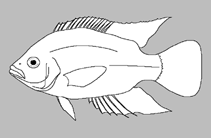Gymnogeophagus peliochelynion Turcati, Serra-Alanis & Malabarba, 2018
Upload your photos and videos
Pictures | Google imageNo image available for this species;
drawing shows typical species in Cichlidae.
Pictures | Google imageNo image available for this species;
drawing shows typical species in Cichlidae.
Common names from other countries
Classification / Names Nombres comunes | Sinónimos | Catalog of Fishes(Género, Especie) | ITIS | CoL | WoRMS | Cloffa
> Cichliformes (Cichlids, convict blennies) > Cichlidae (Cichlids) > Geophaginae
Etymology: Gymnogeophagus: Greek, gymnos = naked + Greek, gea = the earth + Greek, phaegein, to eat (Ref. 45335); peliochelynion: Name from Greek 'pelios' meaning black and blue, and 'chelyne' for lip, referring to the color of the lips of the new species; noun in apposition.
Etymology: Gymnogeophagus: Greek, gymnos = naked + Greek, gea = the earth + Greek, phaegein, to eat (Ref. 45335); peliochelynion: Name from Greek 'pelios' meaning black and blue, and 'chelyne' for lip, referring to the color of the lips of the new species; noun in apposition.
Issue
Entered from e-publication.
Environment: milieu / climate zone / depth range / distribution range Ecología
; agua dulce bentopelágico. Tropical
Distribución Países | Áreas FAO | Ecosistemas | Ocurrencias, apariciones | Point map | Introducciones | Faunafri
South America: Uruguay.
Tamaño / Peso / Age
Short description Claves de identificación | Morfología | Morfometría
Espinas dorsales (total) : 12 - 14; Radios blandos dorsales (total) : 9 - 11; Espinas anales: 3; Radios blandos anales: 8 - 9. This species is distinguished from its congeners of the rhabdotus group and fromG. balzanii by the shape of the caudal peduncle which is longer than deep (vs. deeper than long); differs from all congeners, except labiatus and pseudolabiatus, by having thick lips; differs from labiatus and lacustris by the absence of an oblique bar from the eye to the dorsal-fin origin (vs. present), and by the color pattern of the caudal, dorsal and anal fins with dots (vs. caudal fin and posterior portion of anal fin with longitudinal hyaline stripes); differs from pseudolabiatus and mekinos by the hump entirely black in males (vs. yellow with black margin), and the upper lip not folded dorsally over anterior margin of snout (vs. folded dorsally, usually with a well-developed medial lobe dorsally projected in pseudolabiatus) (Ref. 123558).
Collected in rivers with clear water, usually with rocky or muddy bottom and little vegetation (Ref. 123558).
Life cycle and mating behavior Madurez | Reproducción | Puesta | Huevos | Fecundidad | Larva
Main reference
Upload your references | Referencias | Coordinador : Kullander, Sven O. | Colaboradores
Turcati, A., W.S. Serra-Alanis and L.R. Malabarba, 2018. A new mouth brooder species of Gymnogeophagus with hypertrophied lips (Cichliformes: Cichlidae). Neotropical Ichthyol. 16(4): e180118: 1-9. [First published online with fixed layout, pp. 1-9, 14 Dec. 2018.] (Ref. 123558)
Threat to humans
Harmless
Human uses
FAO(Publication : search) | FishSource |
Más información
Trophic ecology
componentes alimenticios
Composición de la dieta
consumo de alimento
Food rations
Despredadores
componentes alimenticios
Composición de la dieta
consumo de alimento
Food rations
Despredadores
Ecology
Ecología
Home ranges
Ecología
Home ranges
Population dynamics
Coeficiente del crecimiento para
Max. ages / sizes
Length-weight rel.
Length-length rel.
Length-frequencies
Mass conversion
Reclutamiento
Abundancia
Coeficiente del crecimiento para
Max. ages / sizes
Length-weight rel.
Length-length rel.
Length-frequencies
Mass conversion
Reclutamiento
Abundancia
Life cycle
Reproducción
Madurez
Fecundidad
Puesta
Spawning aggregations
Huevos
Egg development
Larva
Dinámica larvaria
Reproducción
Madurez
Fecundidad
Puesta
Spawning aggregations
Huevos
Egg development
Larva
Dinámica larvaria
Anatomy
Superficie branquial
Brain
Otolith
Superficie branquial
Brain
Otolith
Physiology
Body composition
Nutrients
Consumo del oxígeno
Tipo de natación
Velocidad de natación
Visual pigments
Fish sound
Diseases & Parasites
Toxicity (LC50s)
Body composition
Nutrients
Consumo del oxígeno
Tipo de natación
Velocidad de natación
Visual pigments
Fish sound
Diseases & Parasites
Toxicity (LC50s)
Genetics
Genética
Heterozygosity
heritabilidad
Genética
Heterozygosity
heritabilidad
Human related
Aquaculture systems
Perfiles de acuicultura
Razas
Ciguatera cases
Stamps, coins, misc.
Aquaculture systems
Perfiles de acuicultura
Razas
Ciguatera cases
Stamps, coins, misc.
Herramientas
E-book | Guía de campo | Asistente para frecuencias de tallas | Herramienta de ciclo de vida | Mapa de puntos | Classification Tree
| Catch-MSY |
Special reports
Download XML
Fuentes de Internet
Aquatic Commons | BHL | Cloffa | Websites from users | Check FishWatcher | CISTI | Catalog of Fishes(Género, Especie) | DiscoverLife | ECOTOX | Faunafri | Fishtrace | GenBank(genome, nucleotide) | GloBI | GOBASE | | Google Books | Google Scholar | Google | IGFA World Record | MitoFish | Bases de datos nacionales | Otolith Atlas of Taiwan Fishes | PubMed | Reef Life Survey | Scirus | SeaLifeBase | Árbol de la vida | Wikipedia(Go, búsqueda) | World Records Freshwater Fishing | Zoobank | Expediente Zoológico
Estimates based on models
Phylogenetic diversity index (Ref. 82804): PD50 = No PD50 data [Uniqueness, from 0.5 = low to 2.0 = high].
Bayesian length-weight: a=0.01995 (0.00926 - 0.04297), b=3.01 (2.83 - 3.19), in cm Total Length, based on LWR estimates for this (Sub)family-body shape (Ref. 93245).
Nivel trófico (Ref. 69278): 3.3 ±0.5 se; based on size and trophs of closest relatives
Resiliencia (Ref. 120179): Alto, población duplicada en un tiempo mínimo inferior a 15 meses (Preliminary K or Fecundity.).
Fishing Vulnerability (Ref. 59153): Low vulnerability (10 of 100).




